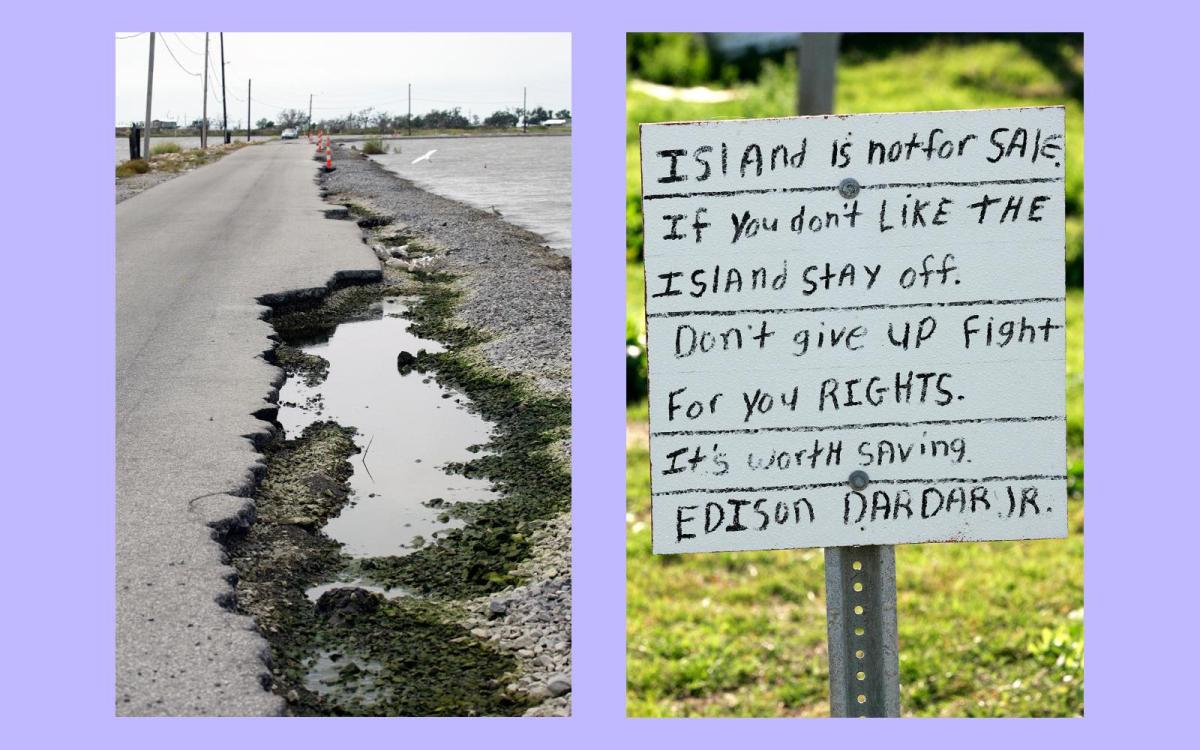
The vision
“Our planet is transforming in a way that will make life much harder for most people. It already has brought suffering to millions and millions of people. And in the United States, most of us are learning about the scale and significance of this crisis at a point when there is not a whole lot of time to shift course. That realization carries both a mental toll and an emotional reckoning.”
The spotlight
Hey there, Looking Forward readers. Today, we’re awaiting the impact of Hurricane Milton’s imminent landfall in Florida — less than two weeks after Helene hit the state and then tore through its northern neighbors. Like Helene, Milton intensified unusually fast as it passed over a record-hot sea surface, made 400 to 800 times more likely due to climate change. (If you’re dealing with the aftermath of Helene, or bracing for Milton, we’ve got a disaster 101 guide here, and recovery guide here.)
While it is absolutely crucial to cover climate disasters like these — and many on the Grist team are doing exactly that — here in the Looking Forward newsletter, our mission is to hold up a vision of a clean, green, just future, and report on the solutions that could help get us there. It can feel difficult to do that when the news of the day is so heartbreaking and grim. But the painful realities of climate change are exactly why we need to put forward ambitious, well-thought-out solutions with all haste, for both mitigation and adaptation.
And grappling with those painful realities, and the difficult questions they raise, is an essential part of getting to the solutions — which is what we’re looking at in this week’s newsletter. Last week, Grist rolled out a series, dubbed “Moral Hazards,” that examines some of the ethical quandaries of living in the era of climate change. For instance, how much responsibility does each of us bear to change our actions, and what does it mean to take meaningful action as an individual? Who counts as a climate villain, when every flight you take and every hamburger you eat is a small piece of a deadly puzzle? Is a policymaker who has fought climate change from within the systems that perpetuate it doing good, or failing to meet the moment?
“We really loved this idea of trying to spark a conversation about climate change on these issues where there aren’t easy answers,” said Kate Yoder, a Grist writer and one of the leaders of the series. She wanted the four stories in the package to “create discussions and leave the reader sort of grappling with these issues, and maybe not even knowing exactly how to feel about them, but wanting to discuss them with someone else.”
Living in the Anthropocene — the name sometimes given to our current geological era, in which humans are the driving force of change on the environment — comes with a host of moral questions. And none of them have simple answers, but being willing to entertain and debate them can inform how we decide what’s right, wrong, enough, and fair when it comes to tackling the climate crisis.
“For so long, there’s been this question about debating climate change — and it’s always debating whether the problem is real or what we should do about it,” Yoder said. But rehashing that false debate is getting in the way of asking the questions that really need to be debated to frame how we move forward. “This is sort of like, Can we reframe debating climate change to actually discussing these real dilemmas that there’s no easy answer to?” Yoder said. “Can we debate those, instead of the problem’s existence?”
Managed retreat
Perhaps no issue illustrates the ethical thorniness of adapting to our changing climate more than managed retreat — the planned movement of communities away from hazard-prone areas, often due to flood risks or sea level rise. What counts as “fair” when deciding who must be relocated, and how they will be compensated?
Grist’s Jake Bittle, who has extensive experience covering climate displacement and disaster management around the U.S., writes:
“When I discuss these stories with readers and friends, I find that people’s reactions depend a lot on who lives in the flood-prone community in question. If it’s a case of a coastal city trying to buy out wealthy beachfront homeowners, readers tend to side with the government trying to force residents to take a payout; if it’s a city trying to buy out a low-income or middle-class neighborhood, readers instead tend to side with the residents. In some cases, in other words, we decide that private property rights trump the public interest, and in other cases we decide the opposite, even when the underlying risk from climate change is the same.”
Even after thousands of home buyouts and local managed retreat efforts across the country, Bittle writes, “there exists nothing close to a rubric for deciding when it’s right for a government to force someone to leave their home for the sake of climate adaptation — or when the government has a moral obligation to protect a community that wants to remain in place.”
Bittle runs through some of the difficult questions managed retreat raises, and ultimately envisions a potential scenario that tackles them quite differently. Instead of dealing with managed retreat community by community, he posits, as individual localities come under imminent threat, what if these decisions were made countrywide, holistically, and well in advance?
Knowing that a community is slated for relocation years or decades out would create an opportunity to involve locals in deciding where and how to preserve certain relics, and allow ample time for moves to happen on residents’ terms.
“What if we didn’t think about relocation as, ‘We’re going to move people out today’?” A.R. Siders, a professor at the University of Delaware and a leading voice on managed retreat, said to Bittle. “What if we thought about it as, ‘Where are the places where the people who are in their homes right now are the last people to own those homes?’ That’s still going to be emotionally difficult and challenging, but you have years to prepare.”
Is an approach like this possible? Debatable. Is it desirable? You can decide. What’s so interesting about it to me is that it takes an issue that raises all these thorny and unanswerable questions and reframes it entirely — we don’t have to grapple only with the questions the way they’re typically posed. We can turn them into different questions that might eventually have more satisfying answers.
Climate shaming
One of the core questions that has long plagued the environmental movement is that of placing blame and pointing fingers. There has been a concerted effort by many prominent voices in the climate movement to shift away from shaming individuals for failing to lead perfectly sustainable lifestyles within an inherently unsustainable system — and a growing understanding that we can happily lay blame on big corporations and actors like fossil fuel execs who knew exactly what they were doing.
But who else deserves blame, and where is the line between those who do and those who don’t? Is blame even a productive tool in this fight?
A group called Climate Defiance has set up camp on one side of this question. The group has gained recognition for its approach to disrupting events and publicly shaming leaders — with the frank goal of “ending the careers and decimating the reputations of those who disagree with us.”
In his profile of the group, editor John Thomason writes: “The way they see it, the rich and powerful have thrown their lot in with those who have a vested interest in continued fossil fuel use, and this cabal is the main thing standing in the way of a fossil fuel-free future.”
That cabal includes oil CEOs and elected officials like retiring Senator Joe Manchin from West Virginia, who has obstructed major climate policy and has well-known financial ties to the coal industry. But it also includes President Joe Biden’s climate advisers, Ali Zaidi and John Podesta, who have been key to some of the administration’s climate victories, and whom the group has targeted on multiple occasions for public shaming.
The approach has clearly resonated; the group raised over $100,000 in a single week last month, and has garnered high engagement on social media, although it’s been less successful getting mass turnout to its actions, which typically have involved a small group of core activists. And Climate Defiance leaders have landed meetings with lawmakers and officials, including some of the same ones they’ve made their targets.
But if average individuals don’t deserve to be shamed, and powerful individuals complicit in the system do, where does the line exist between the two? When does an outsider become an insider, for example? (Climate Defiance funders include Hollywood celebrities and heirs to the Disney and Getty fortunes, and the group counts congresspeople among its supporters). And, if your entire approach is based on shaming those who hold power, when they’re ready to listen, are you ready to propose an alternative?
Thomason recounts that as Climate Defiance prepared for its first sitdown with Vice President Kamala Harris’ campaign team, the group’s demands involved stopping two newly built pipelines and ending federal subsidies for fossil fuel production. Thomason writes: “Given the group’s apocalyptic view on the stakes of the climate crisis, those demands struck me as alarmingly modest.”
Perhaps more than a fully calculated strategy, what Climate Defiance seems to represent is a sense of anger, and determination, that I’m guessing many climate-concerned citizens can relate to. Whether or not you’ve translated it into action, I wonder if some of you might resonate, even a little bit, with the sentiment expressed in this quote from one of the group’s volunteers: “Let’s keep f***ing up shit until these shitty f***ers stop destroying our futures.”
And I highly recommend checking out the other two pieces in the series as well:
- A thoughtful profile by Yoder of climate scientist Patrick Brown, who caused a stir in the scientific world when he wrote an article last year criticizing his own recently published study in Nature that documented the links between climate change and wildfires;
- And a story by Eve Andrews exploring the prevalence of climate anxiety, and how much emphasis we should place on our fears and feelings when many are already fighting to survive the impacts of climate change.
— Claire Elise Thompson
A parting shot
When an approach as sensitive as managed retreat doesn’t take residents’ priorities into account, it can go horribly wrong. In his story, Bittle mentions the Indigenous community of Isle de Jean Charles in Louisiana, where officials began discussing a planned move in 2016, and promised to build a new home for residents that would preserve the architectural style and the fishing traditions of the island. “Instead, they ended up building an ordinary-looking subdivision that tribespeople from the island decried as shoddy and foreign,” Bittle writes. These photos show the problem of erosion on the island — along with some residents’ determination to stay put.



